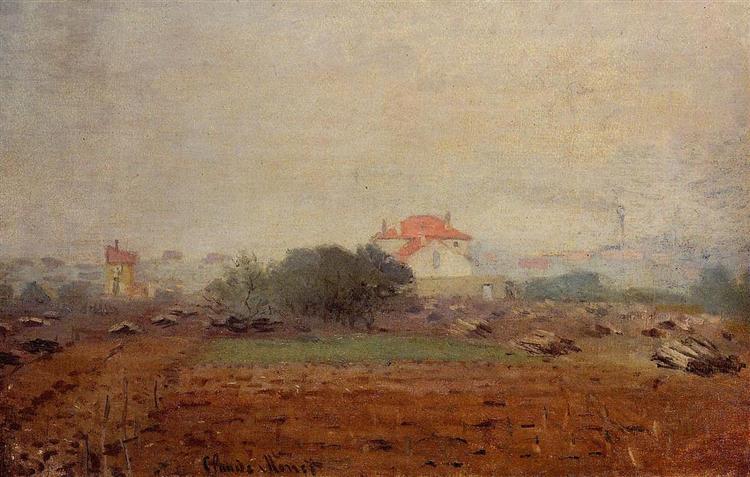Beschreibung
Claude Monet's painting "Fog" (1872) is a fascinating example of the artist's mastery in depicting light and atmosphere through the capture of the ephemeral moment. In this work, Monet transports the viewer to a misty landscape, where the elements blur into an amalgam of subtle and soft colors, establishing a sense of tranquility and mystery.
The painting features a composition that, at first glance, appears almost abstract, illuminated by the mist that permeates the environment. As the viewer's gaze moves across the surface of the painting, vaguely recognizable shapes emerge, suggesting a series of boats anchored at a dock that, in the distance, almost completely merge with the ethereal background. This unstable setting is characteristic of Monet's Impressionist style, who pioneered the use of loose brushstrokes and vibrant colors, applied quickly and directly to capture the essence of the object rather than its defined form.
Monet uses a palette composed largely of greyish tones, soft blues and some flashes of warmer colour, resulting in an enveloping atmosphere that evokes the calm of a foggy day. Mist plays a crucial role in the work, creating an almost painterly layer that softens lines and contours, allowing the elements of the landscape to blend harmoniously with the sky. This also contributes to the sense of mystery, as the viewer feels the desire to explore what lies beyond the mist.
As for the depiction of human figures, it features an almost absent focus; there are no clearly defined characters in the painting. Instead, Monet translates the atmosphere through the interplay of light and colour, suggesting a sense of life from the action of the water and the boats floating at the dock. This choice aligns with the Impressionist tendency to focus on atmosphere and visual experience rather than on formal narratives or portraits.
"Fog" is a work that represents a specific moment in Monet's artistic development and the Impressionist movement in general. By 1872, Monet had already experimented with the plein air technique, which consists of painting outdoors, seeking to capture natural light and the changing atmosphere as a way of challenging and transcending traditional methods. This work, in particular, can be seen in connection with other Impressionist landscapes from the same period, where the exploration of atmospheric effects and the representation of nature as floating images become the focus.
Furthermore, this painting invites us to consider the context in which Monet was working. During this period, the artist was frequently associated with others such as Pierre-Auguste Renoir and Camille Pissarro, who shared a desire to capture the transience of the moment in their work, which became a distinctive characteristic of Impressionism.
Thus, Fog stands not only as a masterpiece of Impressionism, but also as a testament to Monet's particular talent for conjuring a world filled with mystery and ephemeral beauty, turning a simple setting into a captivating visual experience that continues to resonate deeply with the contemporary viewer. Monet's skill in walking the line between form and color, between the visible and the intangible, continues to generate deep admiration and study, enshrining his legacy in art history.
KUADROS ©, a famous painting on your wall.
Hand-made oil painting reproductions, with the quality of professional artists and the distinctive seal of KUADROS ©.
Painting reproduction service with satisfaction guarantee. If you are not completely satisfied with the replica of your painting, we will refund 100% of your money.

